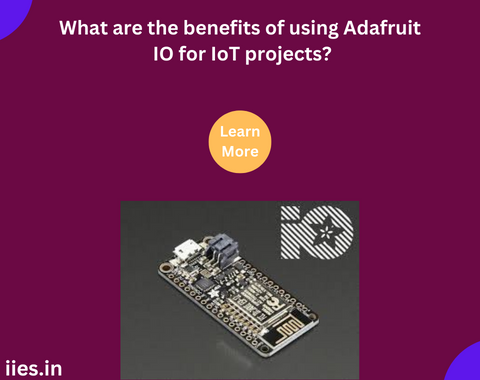Adafruit IO, developed by Adafruit Industries, is a cloud-based service tailored specifically for IoT projects. It serves as a bridge between connected devices and the cloud, facilitating the exchange of data in real-time. At its core, Adafruit IO consists of two primary components: Feeds and Dashboards.
Feeds: Feeds represent individual streams of data generated by IoT devices. Each feed is associated with a unique name and can store various types of data, including sensor readings, status updates, and user inputs. Feeds act as repositories for data, allowing developers to access and manipulate information collected from their devices.
Dashboards: Dashboards provide a visual interface for monitoring and controlling IoT devices. Developers can create customized dashboards containing widgets such as graphs, gauges, and buttons to display real-time data and interact with connected devices remotely. Dashboards serve as centralized hubs for managing IoT projects, offering a user-friendly way to visualize and analyze data.
Features and Functionality
Adafruit IO offers a diverse range of features tailored to meet the needs of IoT developers. Some of its notable functionalities include:
1. Easy Integration:Adafruit IO seamlessly integrates with popular hardware platforms and programming languages, including Arduino, Raspberry Pi, Python, and JavaScript. This compatibility streamlines the development process, allowing developers to focus on building innovative IoT solutions without worrying about compatibility issues.
2. Real-time Data Streaming: With Adafruit IO, developers can transmit and receive data in real-time, enabling instant communication between connected devices and the cloud. This real-time capability is crucial for applications requiring timely data updates, such as environmental monitoring, home automation, and industrial control systems.
3. Data Visualization: Adafruit IO offers robust data visualization tools, allowing developers to create customizable dashboards to display sensor data in a visually appealing manner. Developers can choose from a variety of widgets to present data, including line charts, bar graphs, and pie charts, enabling them to gain insights into their IoT deployments at a glance.
4. Data Logging and Storage: Adafruit IO provides reliable data logging and storage capabilities, ensuring that valuable sensor data is securely stored in the cloud. Developers can access historical data stored in feeds, enabling them to analyze trends, track performance metrics, and make informed decisions based on past observations.
5. Webhooks and Triggers: Adafruit IO supports webhooks and triggers, allowing developers to automate actions based on predefined conditions. Webhooks enable seamless integration with third-party services and APIs, while triggers facilitate the execution of custom workflows in response to specific events, such as sensor readings exceeding predefined thresholds.
6. User Management and Security: Adafruit IO offers robust user management and security features, allowing developers to control access to their IoT projects. Developers can create multiple user accounts with varying levels of permissions, ensuring that sensitive data remains protected against unauthorized access.
Applications of Adafruit IO
The versatility and flexibility of Adafruit IO make it suitable for a wide range of IoT applications across various industries. Some common applications include:
1. Environmental Monitoring: Adafruit IO can be used to collect and analyze environmental data, such as temperature, humidity, and air quality, in real-time. This data can be utilized for purposes such as weather forecasting, pollution monitoring, and agriculture.
2. Home Automation: Adafruit IO enables homeowners to automate and remotely control various smart devices, including thermostats, lights, and security cameras. By integrating IoT devices with Adafruit IO, homeowners can create personalized automation routines and monitor their home’s status from anywhere in the world.
3. Industrial IoT (IIoT): In industrial settings, Adafruit IO can facilitate the monitoring and optimization of manufacturing processes, equipment performance, and energy consumption. By collecting and analyzing data from sensors deployed throughout the factory floor, manufacturers can improve operational efficiency, reduce downtime, and enhance overall productivity.
4. Healthcare Monitoring: Adafruit IO can be utilized in healthcare applications to remotely monitor patients’ vital signs, medication adherence, and activity levels. By integrating wearable sensors and medical devices with Adafruit IO, healthcare providers can track patients’ health metrics in real-time and intervene proactively in case of emergencies.
5. Smart Agriculture: In agriculture, Adafruit IO can help farmers optimize irrigation schedules, monitor soil moisture levels, and track weather conditions to enhance crop yields and conserve water resources. By deploying IoT sensors in the field and connecting them to Adafruit IO, farmers can make data-driven decisions to improve agricultural practices.
Getting Started with Adafruit IO
Getting started with Adafruit IO is straightforward, thanks to its extensive documentation and community support.
1. Create an Account: To begin using Adafruit IO, sign up for a free account on the Adafruit IO website.
2. Set Up Feeds: Once logged in, create feeds to represent the data streams from your IoT devices. Assign unique names to your feeds to distinguish between different types of data.
3. Configure Devices: Configure your IoT devices to send data to Adafruit IO using supported protocols and APIs. Most popular hardware platforms, such as Arduino and Raspberry Pi, have libraries or modules available for integrating with Adafruit IO.

